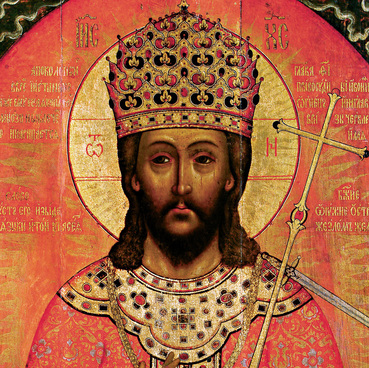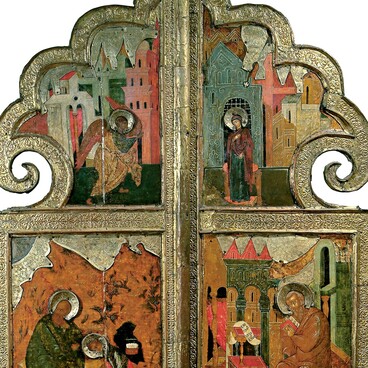What Shall We Call Thee? was made by an unknown icon painter in the middle of the 17th century. The icon was originally located in the Cathedral of the Transfiguration of the Saviour in the Monastery of Our Saviour in Murom. It entered the museum from the Murom Church of Our Lady of Smolensk in 1930.
The icon name is associated with the first hour Troparion to the Mother of God. The Troparion begins with the following words: What shall we call thee, O thou who art full of grace? Heaven: for thou hast dawned forth the Sun of Righteousness. Paradise: for thou hast blossomed forth the Flower of Immortality. Virgin: for thou hast remained incorrupt. Pure Mother: for thou hast held in thy holy embrace the Son, the God of all. Do thou entreat Him to save our souls? Such complex icons based on this hymn are extremely rare.
The iconography of this image dates from the 16th century. Afterwards, the word blessed on the icon was replaced with rejoiced. This means that the icon was made before 1651, when the Patriarch Nikon’s church reforms began. During the reforms, the hymn text was changed.
The icon is dedicated to Our Lady’s service to the dispensation of God. The harmony and tranquility of the hymn icon reflect the Divine Wisdom order. The composition culminates with the figure of the Lord Sabaoth (one of the God’s titles in the Christian tradition) on a throne. He bestows a blessing with both hands. In the lower part of the composition is the Mother of God surrounded by the Archangel Michael and the Prophet Isaiah. She seats atop a magnificent throne. This part of the composition corresponds to the hymn words dedicated to the Mother of God. The prayer says that Mary is called heaven because she gave birth to Christ, the Sun of Righteousness. In the hymn, the Mother of God is praised as the Virgin, because she remained virgin after the birth of Christ.
Beneath this scene there are subjects corresponding to The Nativity of Christ and The Adoration of the Magi. The blessing Christ is in the center of the icon. His figure connects the gate located at the bottom of the iconic composition and the enthroned Mother of God. On the Savior’s left side is John the Baptist and on the right side is the Wise Thief. At Christ’s feet we can see the ancestors Adam and Eve down on their knees. On the icon sides is the hierarchy of the righteous glorifying the Mother of God, including the apostles, martyrs, holy hierarchs, and virtuous men and women.
The icon name is associated with the first hour Troparion to the Mother of God. The Troparion begins with the following words: What shall we call thee, O thou who art full of grace? Heaven: for thou hast dawned forth the Sun of Righteousness. Paradise: for thou hast blossomed forth the Flower of Immortality. Virgin: for thou hast remained incorrupt. Pure Mother: for thou hast held in thy holy embrace the Son, the God of all. Do thou entreat Him to save our souls? Such complex icons based on this hymn are extremely rare.
The iconography of this image dates from the 16th century. Afterwards, the word blessed on the icon was replaced with rejoiced. This means that the icon was made before 1651, when the Patriarch Nikon’s church reforms began. During the reforms, the hymn text was changed.
The icon is dedicated to Our Lady’s service to the dispensation of God. The harmony and tranquility of the hymn icon reflect the Divine Wisdom order. The composition culminates with the figure of the Lord Sabaoth (one of the God’s titles in the Christian tradition) on a throne. He bestows a blessing with both hands. In the lower part of the composition is the Mother of God surrounded by the Archangel Michael and the Prophet Isaiah. She seats atop a magnificent throne. This part of the composition corresponds to the hymn words dedicated to the Mother of God. The prayer says that Mary is called heaven because she gave birth to Christ, the Sun of Righteousness. In the hymn, the Mother of God is praised as the Virgin, because she remained virgin after the birth of Christ.
Beneath this scene there are subjects corresponding to The Nativity of Christ and The Adoration of the Magi. The blessing Christ is in the center of the icon. His figure connects the gate located at the bottom of the iconic composition and the enthroned Mother of God. On the Savior’s left side is John the Baptist and on the right side is the Wise Thief. At Christ’s feet we can see the ancestors Adam and Eve down on their knees. On the icon sides is the hierarchy of the righteous glorifying the Mother of God, including the apostles, martyrs, holy hierarchs, and virtuous men and women.

